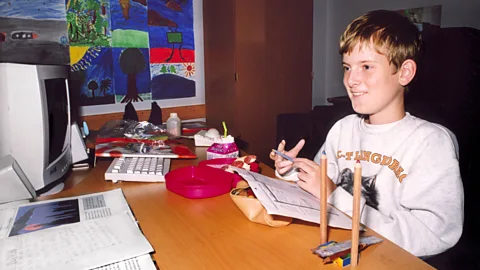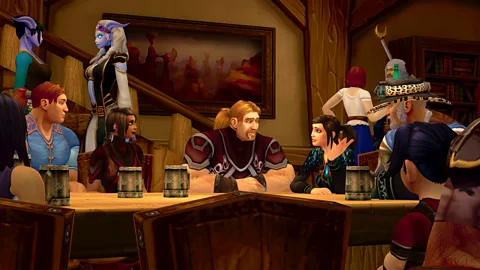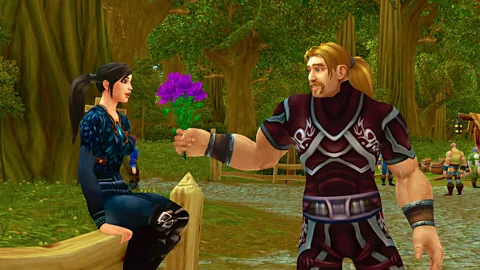 Netflix
NetflixWhen Mats Steen died at the age of 25 in 2014 from a degenerative muscular disease, his parents, Robert and Trude Steen, were surprised to be contacted at their home in Norway by people from all over Europe, mourning his loss. The Steens knew that their son was an avid gamer, but they’d not grasped that for nearly a decade, he had had another virtual life in the game World of Warcraft. The story of Mats, and his avatar Ibelin, is now being told in a documentary, The Remarkable Life of Ibelin.
“I leave this world, and I spend most of my time in a distant world called Azeroth,” begins Mats Steen in the film, his words spoken by an actor, introducing the audience to the virtual landscape familiar to players of World of Warcraft. “In there,” he continues, “my chains are broken, and I can be whoever I want to be.”
To discover that their son, who had Duchenne Muscular Dystrophy (DMD) and used a wheelchair for much of his life, experienced much of what other young people his age did – socialising, friendship, love – was a revelation to his parents. “He was born more than 35 years ago now, we lived under the same roof as him for 25 years, four months and 15 days,” Robert Steen tells the BBC. “Then he died having suffered quite severely from the disease that he was born with. And we believed that he lived a lonely and isolated life, without experiencing love or being important or making a difference in the lives of other people, because that is all we saw. The day after his passing, we inserted a small post into his blog saying he’d passed away, as we thought we ought to, since he spent so much time in the gaming world. That’s when emails started to come in telling of [people’s] strong relationships with Mats. And that was the turning point of our own life. His death was also the beginning of the story, because in the 10 years since he’s passed, we’ve learned so much about his life.”
Mats Steen’s double life was first explored in 2019 by Norwegian public broadcaster NRK and then in a BBC News article, which inspired Norwegian film-maker Benjamin Ree to tell the story as a documentary. “I think his story asks some questions that are really relevant today,” he says. “Is it possible to become friends with someone you’ve never met? Is it possible to experience love with somebody you’ve never met? And how close a friendship can you have with someone you’ve never spoken to, just written to? And at the same time, I think it says something about the generational gap, about my generation’s fascination for gaming – I’m 35 years old – and being in a virtual world. Mats really came of age within that game. Also, both Mats’s friends and family have told me that towards the end of his life, he really wanted to have mattered. He seemed to have lived such a short life, but he wanted to be remembered.”
 Netflix
NetflixRee crafted the documentary using VHS footage of the Steen family, as well as using an actor to recite parts of Steen’s blog, titled Musings of Life, which was published shortly before his death in 2014. While some of his friends from World of Warcraft are interviewed, Ibelin and other avatars from the game are animated. Steen had also interacted in the game by text, not by voice, and all his communication had been stored while he was gaming. His online community (known as a “guild” within World of Warcraft), called Starlight, helped make around 42,000 pages of discussion and directions available to Ree, so that he could piece together Steen’s inner life as Ibelin. Ree describes it as “like a film script that’s 42,000 pages long, which really tells the story of an actual lived avatar life during those eight years”.
“All of Ibelin’s feelings and actions were in that archive,” he says. “So, if Mats wrote, ‘Ibelin seems sincere yet saddened,’ we knew exactly where and when that happened, and in the film, we try to interpret the complexity of the writing and the emotion into actual animation.”
Just how possible is it for an online avatar to represent a real person? Mats Steen named his alter ego after Orlando Bloom’s character Balian of Ibelin in Ridley Scott’s 2005 historical epic Kingdom of Heaven. In the game, Ibelin is tall, muscular and blond, and runs through Azeroth for 30 minutes each day. He introduces himself in the documentary as “Ibelin Redmoore, famed detective and nobleman, who finds friends and fights evil wherever he goes”, and Steen describes the character as “an expansion of myself, of different parts of me”.
A generational divide
Ibelin Redmoore may sound like an idealised superhero, perhaps because he was created by a 17-year-old, but Steen’s parents received messages from other players saying that he “would always lighten the mood” in the game. Another tribute read, “He was there for me, and I could also talk to him about the stupid things.” The film meets Xenia from Denmark and her son Mikkel, who play online as their avatars Reike and Nikmik, and she says that Steen’s mature advice was essential in helping them improve their mother-son relationship.
Another friend, Lisette from the Netherlands, recounts how the teenage Steen wrote a letter to her parents when they took her computer away from her as her grades were suffering, asking them to find a different solution, because she was depressed. “I think she’s a great person and I consider her one of my closest friends,” he had written.
 Netflix
Netflix“He was an incurable romantic and always had success with women,” another friend of Ibelin’s wrote to the Steens. And it was Lisette, in the form of her avatar Rumour, who seems to have been the great love of Steen’s life: the two met in the game when they were around the same age as teenagers. In the documentary, Ibelin encounters a “dark-haired, mysterious beauty” who steals his hat. Later, they exchange a kiss on the cheek. “It was just a virtual kiss, but boy could I feel it,” Steen says about the meeting.
Science experts have suggested that the human brain processes video games as if they’re really happening. Although many societies are currently discussing the harm done to young people by too much smartphone and online time, Steen’s father says he’s re-evaluated the value of his son’s virtual encounters. “Mats told us he was gaming with other people, but we felt they couldn’t know him as they hadn’t met physically,” Robert Steen says. “Yet I think if you move ahead 10 years in time, we won’t even have these kinds of conversations, we’ll not differentiate between the digital and physical. For younger people, digital or physical, it’s all very much the same, the relationships they’ve established online are as important and natural as physical relationships. It’s just my generation where this is strange, as we never experienced it growing up.”
Some of the Starlight group attended Steen’s funeral, and still hold gatherings in his honour, which Ree says is proof of the real friendship that exists within gaming. “I think that amount of time these gamers spend together is much more time than I get meeting my friends in real life,” he says. “The amount of time they role-play or game together, or also just talk about the serious stuff, I think there’s great value in that. And I found out that Mats was great at asking the question, ‘How are you doing?’ and really listening to the answer afterwards.”
Not that the film portrays Ibelin, or Steen, as saint-like. As Steen’s health deteriorates and he becomes more frustrated at the limitations of his physical life, Ibelin has more outbursts and lashes out at fellow players. The Steens explain that their son also created another avatar at the age of 21, called Jerome Walker, who doesn’t feature in the movie. “Jerome was a cowboy; he was drinking whisky and dancing,” Robert Steen says. “He was flirting with women all the time and so on and so forth, so that was probably him mirroring the 21-year-old he became, rather than the 17-year-old who created Ibelin. But Mats was clearly using the avatar to experience things which he would’ve liked to in physical life.”
 Netflix
Netflix“It’s a good thing I’m in this wheelchair or I’d be out giving my mother a heart attack,” Mats Steen writes.
Indeed, what makes the story so compelling and well-received (it won both the directing and the audience awards at the Sundance Film Festival, often a harbinger of an Oscar nomination) is the character of Mats Steen that Ibelin helps reveal – his strength, his humour, and occasionally his melancholy. “In this other world, a girl wouldn’t see my wheelchair or anything different, they would get my heart, soul and mind conveniently placed in a handsome strong body,” Steen says about life in Azeroth. “At high school there were parties, attractive girls, so many things a boy of 17 years old desired, but they were all just dreams, things beyond my reach. Dreams are nice, though, in this way. You can always visit again.”

